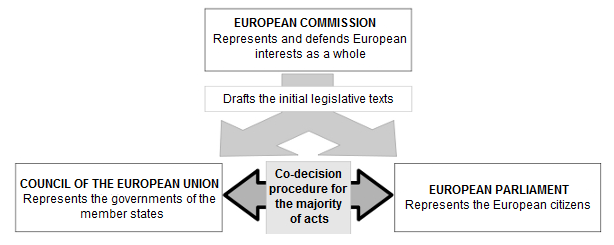Institutions
Establish priorities
The European Council (not to be confused with the Council of the European Union) sets the EU’s broad priorities but does not have the power to adopt legislation.
Led by a president (currently the Belgian Charles Michel), the Europe Council is composed of the heads of state and government of the 27 member states, along with the President of the Commission.
The Council comes together at least once in three months, for several days.
The legislative process
The institutional triangle
The “ordinary legislative procedure” (or co-decision) enables these three institutions to adopt policies and legislation which will be implemented across the EU.
Simply speaking, the Commission (led by commissioners nominated by national governments) presents legislative proposals which are then adopted by the Parliament (members elected directly by universal suffrage) and the Council of the European Union. This latter institution is made up of the ministers of the governments of each member state and presided by a different member state every six months.
Once adopted, legislative acts are implemented by member states and the Commission, equally responsible for ensuring that they are applied correctly.
Principal tasks of the institutions
The European Council
- Definition of general political guidelines and priorities
- Summits of the heads of state
- Publication of conclusions of decisions taken
The European Commission
- Submission of legislative proposals to the European Council and Parliament
- Policy implementation and budget management
- Supervision of the application of European law (together with the Court of Justice)
- Representation of the EU on the international stage
The Council of the European Union
- Adaptation of the legislation (with the European Parliament)
- Policy coordination
- Elaboration of the common foreign and security policy
- Conclusion of international agreements
- Budget approval (together with the European Parliament)
The European Parliament
- Legislative power (adaptation of legislative acts together with the European Council)
- Supervisory power (exercise of democratic control over European constitutions)
- Budgetary power (together with the European Council)
Other institutions
Three other institutions play a vital role
- The Court of Justice of the European Union, responsible for ensuring that EU law is respected
- The European Court of Auditors controls the financial management of the EU’s activities
- The European Central Bank manages the European single currency and directs European monetary policy
Functioning of the EU
The European Union is the “economic and political association” of 27 states belonging to the European continent.
The aims of the European structure are to maintain peace, seek political unity and assure the economical and social progress of all its members. In order to implement this common ideal, a complex and unique institutional organisation was created.
Exclusive, shared and supporting competences
The EU is not a state, but an organisation acting upon the competences it has been assigned by the member states. It is active in a wide range of areas.
Next to the national, regional and local powers thus exists a European power founded on democratic and independent institutions, mandated to intervene in several areas.
- The states can decide to transfer the entirety of their competences in one area: for example, commercial, agricultural or monetary matters. This is referred to as exclusive competence. In this case the states can no longer intervene alone.
- The states only transfer a part of their competences and can therefore continue to act alongside the EU. This is referred to as shared competence and is the most common case. The EU acts in place of the states if joint action is considered more effective than the states acting separately.
- There also exist supporting competences: in this case, the main competence lies with the member states. However, the EU can support their actions. This is the case for research matters, or for matters concerning public health.
European treaties and legislation
The legal structure of the European Union is based on treaties approved by the member states. The Lisbon Treaty, approved in 2009, stipulates the entirety of the EU’s competences. In 2012, the treaty on stability, coordination and governance, or “European Fiscal Compact”, was approved. In the context of financial crisis it aims at reducing debt financing of the EU member states.
Beside treaties defining the fundamental rules of EU action (constituting the “primary legislation” of the EU), there exists a “secondary legislation”. In short, it comprises all the legislative acts of the EU (directives, regulations and decisions) that ensue from the principles and aims defined in the treaties.
The Commission is charged with both elaborating and implementing legal proposals. These proposals have to be approved by:
- The European Parliament, directly elected by the citizens
- The Council of the European Union which reunites the governments of the 27 member states



